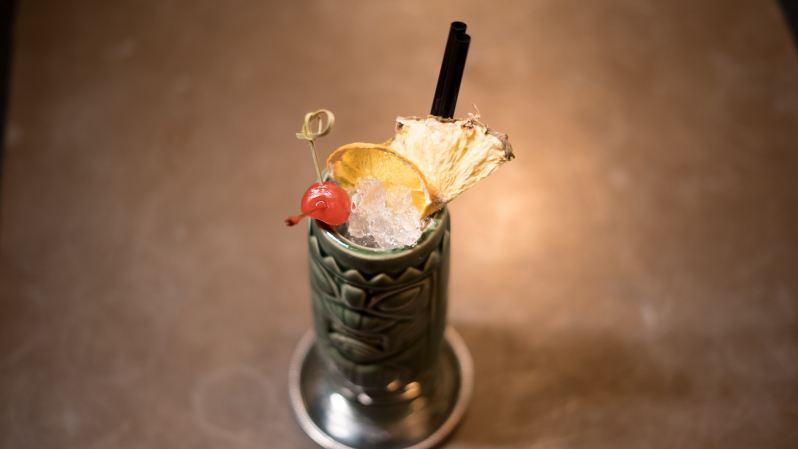
Whether it’s the midst of the summer heat or the middle of a frigid winter, there’s no wrong time for a Mai Tai. This classic tiki cocktail of rum, curaçao liqueur, orgeat syrup, and lime juice is either a comforting, tropical respite from winter or the perfect accompaniment to literally having your feet in the sand on a hot summer day.
For those unaware, Tiki is a style of bartending that involves mostly rum-based cocktails in a tropical setting made to pay tribute to island cultures, most notably Polynesian culture. Popularized in the 1950s and ’60s, drinks like the Mai Tai, Hurricane, Blue Hawaiian, Rum Runner, Painkiller, and others have seen a resurgence with the rise of cocktailing and a renewed interest in classic drinks.
Why wouldn’t it? Something is exciting about walking into a bar adorned with bamboo, rattan, fake grass, seashells, and highly elaborate mugs and tiki glasses. Plus, sipping these high-octane rum-based cocktails is like taking a trip to an island paradise without ever leaving your city.
The Mai Tai drink recipe was created by famed Tiki pioneer Victor J. Bergeron at his iconic restaurant Trader Vic’s in Oakland, California, way back in 1944. This tropical cocktail is known for its sweet, boozy flavor, featuring notes of orange zest, lime juice, almond cookies, and molasses.
As mentioned above, this rum-driven drink also contains curaçao liqueur. This blue-hued liqueur gets its flavor from the dried peel of a bitter orange called laraha, found on the Dutch island of Curaçao. It’s rounded out with fresh lime juice and orgeat syrup. For those unfamiliar with orgeat, it’s a popular Tiki drink ingredient made with almonds, sugar, and rose water or orange flower water.
Even though many of the ingredients sound exotic, you won’t have a hard time finding them at a liquor store or supermarket. It’s also fairly easy to make. This sweet, flavorful, refreshing cocktail will surely become your new go-to after you make it once. Keep scrolling to see our favorite simple, elegant, easy-to-maneuver recipe.

Best Mai Tai recipe
Ingredients:
1.5 ounces white rum
.5 ounce fresh lime juice
.75 ounces curaçao liqueur
.5 ounces orgeat syrup
Dark rum topper
Preparation:
- Add all ingredients except dark rum to a shaker.
- Shake vigorously.
- Strain into an ice-filled highball glass.
- Top with dark rum.
- Garnish with a lime wheel.
The best part? Like with any great cocktail, you can change the amounts of each ingredient to mix up the flavor experience and craft the drink to fit your palate. Depending on the quantities of each ingredient it will be sweeter, more bitter, or more citrus-driven. Add more white rum if you want to add a little boozy element. Leave room for more dark rum if you want more molasses, oak, and vanilla. More orgeat means more almond flavor. More curaçao liqueur means more orange blossom flavor. Additional fresh lime juice adds a tart, citrus-filled element. All in all, it’s a great cocktail you’ll want to mix up all year long to impress your friends and family.
The key is to have fun with it. It’s supposed to be a drink that transports you to a tropical paradise; don’t overthink it. Make some Mai Tais, take off your shoes, and dip your toes in a lake, pond, or kiddie pool — or bury them in beach sand or your nearest sandbox.



